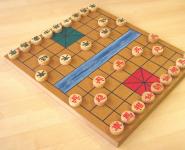How to learn to play chess from scratch
If you want to learn how to play chess from scratch, take note of these 5 helpful tips. My grandfather used to say that highly developed intellectuals prefer to play chess. This is not for you to “beat the goat” or knock on dominoes for a sip of foamy beer. On the chessboard, you can realize countless combinations that are not yet known to your opponent. To master the game of chess with zero knowledge, you need to put into practice the tips listed below.
- First you need to know how each piece is called and moves. This is the basis of the chess game and the basics of combinatorial creativity.
- A chess game is a battlefield on which the partner's forces are concentrated. Your main task is to learn to analyze the situation and simulate in the brain all the possible moves of a skilled opponent.
- Try to play as often as possible with a more prepared opponent. At the very beginning, take a handicap in the form of a rook or a queen. Gradually, the handicap will reach a lower level, and your practice and ability to lose with dignity will give you a long-awaited draw. Yes, it's a draw. And only then the first victory.
- Learn to parse already played chess games of famous grandmasters and world champions. This will allow you to introduce fundamentally new combinations into your technique.
- Continually develop your memory and analytical skills. Gain related knowledge that can help you in an effective chess game.
This is just a small summary of five useful tips. And now everything is in order.
What kind of game is chess
Chess was born in India 2000 years ago. The name of this game is very mysterious, but when translated into Russian, everything is quite simple. "Shah" is the King and "Checkmate" is the end. Together, it turns out "The End of the King."
The Indian Shah-Padishah was very fond of this game and played it all day and night long. And when guests from other countries came to him, the shah would always give them a chess set.
Over time, chess has spread all over the world, and now this wonderful game is played in all countries of the world, including Russia.
To begin with, it is worth saying that chess is a game involving two people. The pieces they move with are located on different sides of the board, which contains 64 black and white fields. Different figures alternately move along 64 squares of the board. The game begins with the correct installation of the board. It is necessary that each of the players have a white square in the lower right corner, respectively, black on the left.
The chessboard is marked horizontally with letters from a to h, in the vertical direction - with numbers from 1 to 8. It is with their help that the current game is recorded.
Heroes of the game - chess pieces

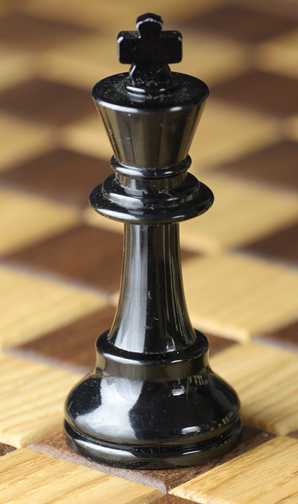 King. This is the most important figure, but rather weak. If the king is checkmate, then the game is lost. He can move to any field adjacent to him only one cell. The main goal of the game is to put the opponent's king in a stalemate and declare checkmate to him. If you succeeded, then you have won.
King. This is the most important figure, but rather weak. If the king is checkmate, then the game is lost. He can move to any field adjacent to him only one cell. The main goal of the game is to put the opponent's king in a stalemate and declare checkmate to him. If you succeeded, then you have won.
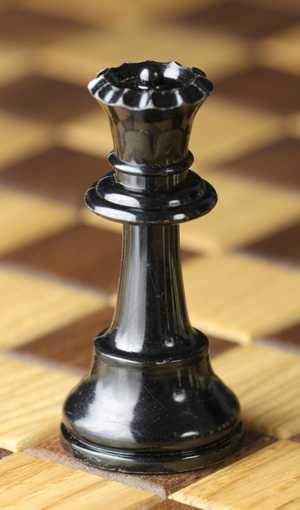 Queen. The strongest figure. She is also called the queen. She walks as she wants: diagonally, vertically, and horizontally, back and forth. The queen in one move can pass both the entire chess field and one cell.
Queen. The strongest figure. She is also called the queen. She walks as she wants: diagonally, vertically, and horizontally, back and forth. The queen in one move can pass both the entire chess field and one cell.
 Rook. It is the second most powerful piece in chess. She moves almost exactly like a queen, but not diagonally.
Rook. It is the second most powerful piece in chess. She moves almost exactly like a queen, but not diagonally.
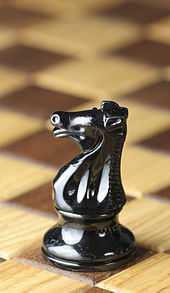 Horse. This is quite an interesting figure. He moves in this way: 2 squares back, 1 to the side, or 2 squares to the side, 1 back, as well as 2 squares forward, 1 to the side, or 2 squares to the side, 1 forward. The knight changes the color of the field with each move.
Horse. This is quite an interesting figure. He moves in this way: 2 squares back, 1 to the side, or 2 squares to the side, 1 back, as well as 2 squares forward, 1 to the side, or 2 squares to the side, 1 forward. The knight changes the color of the field with each move.
 Elephant. This piece can only move diagonally, backwards or forwards. He walks through the cells only of his own color, that is, if the horse is white, then in white, and if black, then in black.
Elephant. This piece can only move diagonally, backwards or forwards. He walks through the cells only of his own color, that is, if the horse is white, then in white, and if black, then in black.
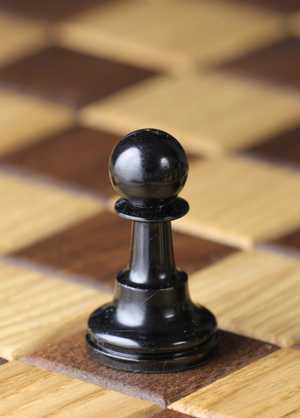 Pawn. The weakest figure. The pawn moves only forward, and only one cell, only from its original position, and once it can make a double move (that is, through the cell, for example, a2-a4). But if the pawn manages to go through the whole field, then reaching the last cell on the row, it can become any chess piece, of course, except for the king.
Pawn. The weakest figure. The pawn moves only forward, and only one cell, only from its original position, and once it can make a double move (that is, through the cell, for example, a2-a4). But if the pawn manages to go through the whole field, then reaching the last cell on the row, it can become any chess piece, of course, except for the king.
Arrangement of pieces in chess
If you do not know how to arrange chess on the board, then read this paragraph. Opponents play on opposite sides of the board, one of them moves with white pieces, the second with black pieces. The pieces in each game are placed in the same way as follows:
Lines number 2 and 7 are pawns;
The corners of the board are rooks;
Next to the rooks are horses;
Next to the horses are elephants;
In the middle - a queen (should stand on a cell of the same color as it: white - on white, black - on black);
Next to the queen is the king.

The first move in the game goes to the player with white pieces (the decision on who plays which pieces is made by lot). So, first the white pieces move, then the black ones, then again the white ones, then the black ones, and so on.
The meaning of the game of chess
When the beginning of the game takes place, there are 16 pieces on both sides. The main goal of the game is to checkmate the opponent's king. Checkmate in this case is a situation in which the opponent's king cannot get away from the check. This situation takes place only when all the cells around are occupied by their pieces, or they are located under the attack of the opponent. Checkmate is also possible if it is impossible to close the check with another piece, or you yourself cannot take the piece that declared the check.
How to play chess correctly?
You have learned how all the chess pieces move individually. But if one figure blocks the path of another, what should be done in this case? You should do this: if your figure is on the way, then the path is closed. However, if the opponent's piece, the path can be cleared by beating it. It happens like this: you remove the opponent's piece from the board, and in its place you put your own piece, with which you beat it. It's all one move. But it is not necessary to beat the pieces.
Let's look at an example:

To the right and left of the white pawn are a black piece, if it's White's move, then the pawn can beat both one and the second piece and stand in its place.
Almost all the pieces during the game move around the board, beat each other, are removed from the board. Only the king cannot be removed from the board. He can be declared “check”, that is, a warning that he can be beaten. If he gets a “check”, you must immediately react, leave this position. This can be done as follows: by leaving for a safe field, defending it with another piece, capturing the attacking piece. If you do not have the opportunity to protect your king, then you have been checkmated. The party is lost. When writing "check" denote +, checkmate - x.
There are 2 more exceptions to the rules of chess
- You already know that only 1 piece can be moved in one move, but each player is allowed to make a double move once - castling (simultaneously rearrange the rook and king). It is done like this: move the rook to the king, throw the king over it and place it on the other side. Castling cannot be done if: after castling, the rook and king should not be under attack; the king is in check; the rook and king have already moved.
- This exception applies only to pawns. You can capture a pawn on the aisle while it makes a double move. Once the opponent's pawn has made a double move, you can remove it from the board by placing your pawn on the field as if the opponent's pawn had made a simple move. You can capture a pawn on the aisle only immediately after a double move. If you don't take it right away, you won't be able to. For example, the white pawn on a2 made a double move to a4. The black pawn a!4 can remove the white pawn from a4 and stand on a3, as if the white pawn had made a normal move.
During the game, observe the main rule of chess: if you touch a piece, you must resemble it. Therefore, if you have not thought out the next move in advance, you should not touch the pieces.
You have been introduced to the most basic rules of chess, and now you can play your first game of chess.
How to learn chess annotation?
The annotation is the designation of the pieces on the board. Beginners and children who want to seriously engage in this game should definitely learn this. To describe a chess game, there is a kind of chess language. It's pretty simple. All cells of the chess field are indicated by a Latin letter and a number. Horizontals are indicated by numbers, verticals by letters.
The score is kept from the left field of the white pieces. For example: a1, c2, d3, h4, f8. When recording a figure, the designations are abbreviated: queen - F, king - Kr, knight - K, bishop - C, rook - L, pawn - not indicated.
For example: a2-a4 the number indicates the sequence number of the move, the pawn moved from the a2 field to the a4 field.
You can record the move in abbreviated form, indicating only the “point of arrival”. For example: a4.
Black's move is recorded with three dots before recording. For example: ...a5 - the black pawn moved from a7 to a5.
The capture of a piece is written ":". For example: Q: a7 - the queen took the pawn a7.
Chess: rules of the game. Checkmate.
A little earlier it was said that the main goal of a chess game is to checkmate the opponent's king. To do this, the king must get into check, but he can get out of it using one of three ways:
- Ensure safety by moving to another square of the board (castling is not allowed in this case);
- To take a piece himself, with the help of which the opponent is going to check (if possible);
- Defend against an attacking piece with another, with your own piece.
If it is impossible to avoid checkmate, the game comes to an end. In this case, the king remains on the board, but the game is considered over.
Also, if you want to learn how to play chess, learn the basic rules, you need to know when a draw is declared. There are 5 rules:
- If a player should move next, but cannot do so due to the position of the pieces;
- Consent from both players;
- The lack of a sufficient number of pieces on the board, allowing you to checkmate the opponent;
- 50 consecutive moves were made, however, none of the opponents made moves with pawns, as well as capturing a pawn or piece of the opponent;
- The player can declare a draw in the event that there was a three-time repetition of identical positions.
TIPS ON THE RULES OF CHESS FOR BEGINNERS
The above is enough for you to sit down to play chess - with a friend, with a child, or just with a computer program. But to play successfully, you need to take into account at least something else.
First, always think: why did the opponent go this way or that way? What is he up to? If you unravel his plan, then with a high probability you will be able to find protection.
Second, try to develop your plan. For example, it makes no sense to just put "check" just to proudly pronounce this word if the opponent can easily defend against your single attack. But if you start attacking the enemy king with several pieces of your "army" at once, then this will have a much greater effect.
Third, know the value of each piece. It is foolish to "eat" someone else's pawn in order to immediately lose your queen. When exchanging pieces, take into account their conditional price: a knight and a bishop cost about three pawns, a rook - six, a queen - nine. The king, as you know, is priceless.
Fourth, try to control the center of the board, at least the central four squares. The pieces in the corners and on the edges are less agile, they are less involved in the game. That is why, by the way, do not delay the introduction of significant pieces into the game - you cannot win the initiative with pawns alone!
Fifth, remember that "double" pawns (that is, standing on the same line after you "ate" an opponent's piece with one of them) cannot defend each other. This is especially important at the end of the game.
Sixth, always think about the safety of the king! No matter how confident the position of your pieces on the board looks, all this will be useless if your king is under attack and cannot avoid it.
And most importantly - have fun!
For all the time this material was viewed: 8 758, including today: 12
